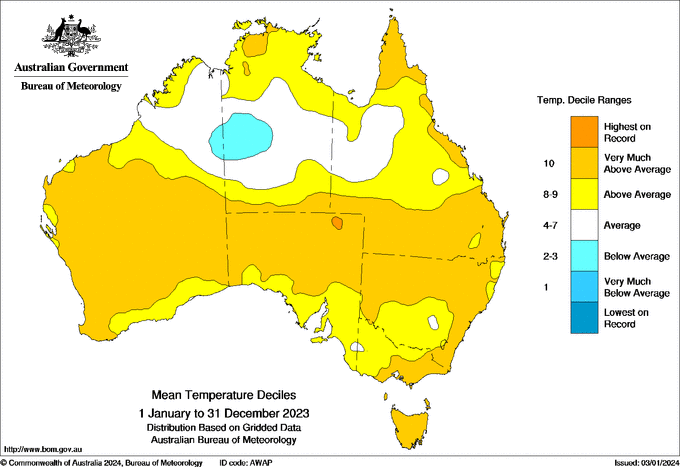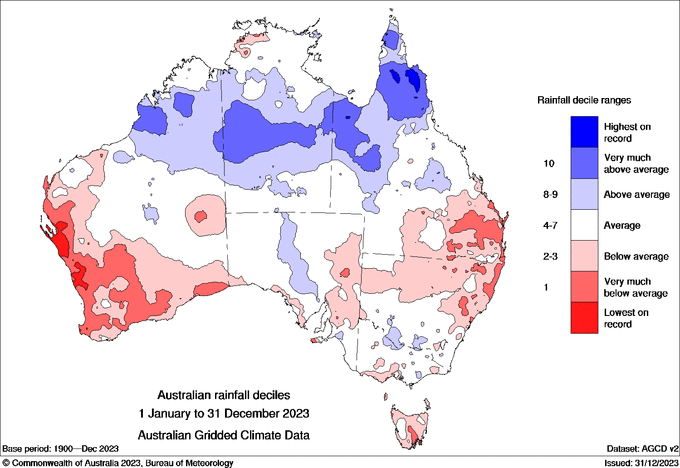Australia recorded its equal eighth warmest year on record last year, according to new data from the Bureau of Meteorology.
The government agency's Annual Climate Statement has revealed the temperature the year was the warmest since 2020, according to national records which began in 1910.
Australians also experienced warmer temperatures during the colder months, with data revealing the national mean temperature was 1.53 degrees above the 1961–1990 average in winter.
READ MORE: CCTV sought as search resumes for missing Victorian woman
According to the report, both the mean annual maximum and minimum temperatures were above average for all states and the Northern Territory.
"There was widespread warmth throughout the second half of the year," the report said.
"The mean national temperature for June, July, August, September, November and December were among the ten warmest on record.
"The exception was October which was the 15th warmest."
Australia also experienced above-average rainfall in the north and below-average rainfall in parts of the east, south and west.
READ MORE: Man died after damage caused by doctor
Queensland and the Northern Territory had above-average rainfall overall last year, while all other states and territories had below-average rainfall in 2023.
Major flooding events were experienced across inland and northern regions of the country in the first quarter of 2023.
By contrast, August to October last year was Australia's driest three-month period since national rainfall records began in 1900.
"Surface water storages declined in 2023, including those in the Murray–Darling Basin," the report said.
"However, Australia's total surface water storage volume remained high at the end of 2023."
Tropical cyclones also featured in the year, which resulted in heavy rainfall and flooding in northern areas in early and late 2023.
New South Wales and the Australian Capital Territory
New South Wales had 428.89mm rainfall in 2023 overall in 2023, as an area average across the state, which is 22.9 per cent below average.
The mean temperature 1.3 degrees warmer than the 1961-1990 average, which made it the sixth-warmest since records began in 1910.
Victoria
Victoria overall had 628.00 mm rainfall in 2023, as an area average across the state, which is 5.3 per cent below average.
The mean temperature was 0.69 degrees warmer than the 1961 to 1990 average for Victoria and the warmest since 2019.
Queensland
Queensland overall had 695.23mm rainfall in 2023, as an area average across the state, which is 11.7 per cent above average.
The mean temperature was 1.17 degrees warmer than the 1961 to 1990 annual average, which made it the 10th warmest since records began in 1910.
Tasmania
Tasmania overall had 1201.84mm rainfall in 2023, as an area average across the state, which is 11.5 per cent below average and the lowest rainfall total since 2017.
According to the Bureau of Meteorology, 2023 was Tasmania's third-warmest year on record.
The mean temperature was 0.81 degrees warmer than the 1961–1990 annual average, while also being the warmest year for Tasmania overall since 2016.
South Australia
South Australia overall had 195.79mm rainfall in 2023, as an area average across the state, which is 12.5 per cent below average.
The mean temperature was 1.15 degrees warmer than the 1961 to 1990 annual average, while also being the equal seventh-warmest since records began in 1910.
Western Australia
Western Australia overall had 332.27mm of rainfall in 2023, as an area average across the state, which is 2.8 per cent below average.
The latest data from the Bureau of Meteorology has determined 2023 was Western Australia's sixth-warmest on record.
The mean temperature was 1.03 degrees warmer than the 1961 to 1990 average for Western Australia.
Northern Territory
The Northern Territory overall had 625.73mm of rainfall in 2023, as an area average across the Territory, which is 14.8 per cent above average.
The mean temperature was 0.36 degrees warmer than the 1961 to 1990 average for the Northern Territory and the coolest since 2012.





